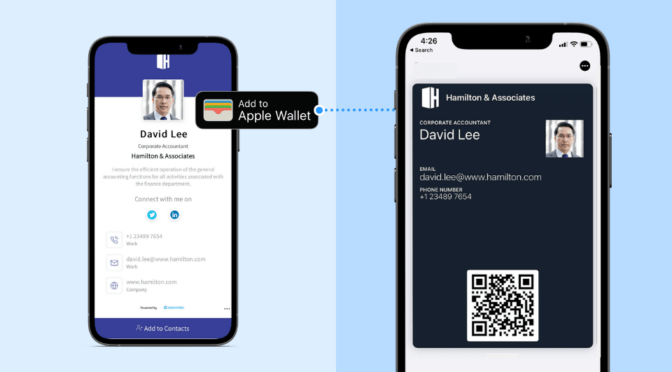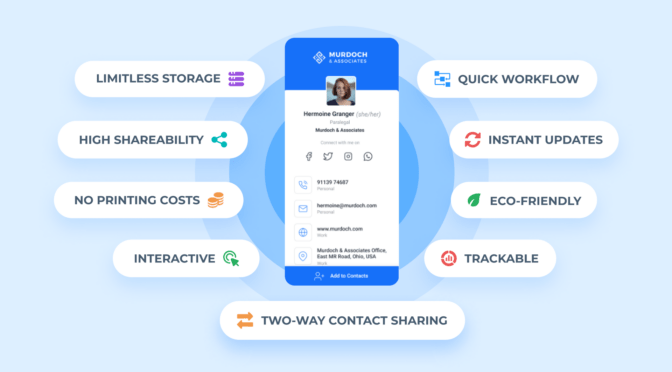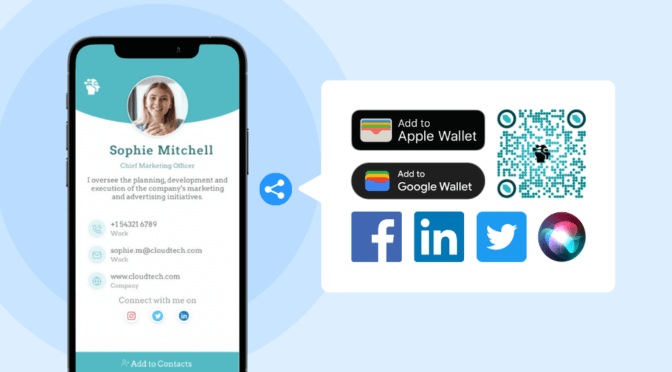According to a LinkedIn study, 80% of business professionals believe professional networking is essential for career growth.
But when you rely on paper business cards for your networking, even seemingly harmless errors, such as forgetting to carry your cards to a meeting, could negatively impact your networking results.
Nevertheless, forgetting your card or other such errors does not have to ruin your professional networking efforts.
When you switch to digital business cards, there are no physical cards to run out of, forget, or misplace. And it takes a simple camera scan for your recipients to access your business card content and save it in their phonebook.
Here’s an overview of the top professional networking mistakes you can avoid simply by switching from paper to digital business cards.
4 Examples of how paper business cards affect your professional networking
- Providing out-of-date and insufficient information to clients
- Introducing inconvenient friction points during networking
- Forgetting to bring your business card to networking events
- Making unnecessary follow-up calls to confirm if a client is interested
1. Providing out-of-date and insufficient information to clients

Effective communication is key to improving your business. This is why it is important to understand the types of information your clients seek and how you can provide them.
Often, exchanging business cards is customary during events or meetings. Rarely, however, does a client desire only your basic contact details. They may also wish to learn more about you before taking things further.
Due to their compact size, outdated networking tools such as paper business cards do not provide enough content space to convey all the details your clients require. As a result, you often end up providing insufficient information.
Moreover, paper business cards also become outdated with the slightest change in your contact details. You must reprint and reshare your cards to avoid conveying inaccurate information to your clients.
You can address this restrictive spacing issue with digital business cards (or virtual business cards) and update your cards as and when needed.
In addition to your basic contact details, you can provide as much interactive information as your clients require with digital business cards—website URLs, social handles, Google Maps location, and more.
You can also make real-time, back-end updates to this information without having to recreate or reshare your card.
2. Introducing inconvenient friction points during networking
Suppose you have turned a prospect into a warm lead during a sales presentation. And it concluded with an exchange of paper business cards. After the card exchange, the traditional approach leads to a string of manual and cumbersome tasks.
Your prospect must manually save your contact details on their mobile devices. And you must enter your prospect’s details by hand into your company’s lead management or CRM software.
Switching to virtual business cards lets you eliminate these manual processes. This is because digital business cards are highly interactive, unlike their paper counterparts.
Your recipients can click to access all the information you present, whether it’s a phone number to your enterprise contact center, social media handle, or a web URL. The best part is that your clients can save this information on their mobile devices without manual typing.
In addition, digital business cards offer two-way contact sharing. This capability lets you capture your client’s information via a form directly from the card you share.
Once your recipient submits the contact form, it is automatically recorded in your virtual address book (on your digital business card provider’s dashboard). From here, you can view and manage all the leads you have collected via your virtual business card.
You can also integrate this address book into your organization’s CRM (e.g., Salesforce or 700+ other CRM software via Zapier). This means you do not have to manually record every lead you gather on your organization’s CRM software.
3. Forgetting to bring your business cards to networking events

Attending networking events is one of the most effective means to find new clients for your business. But participating in these events requires preparation. And you must ensure you are equipped with every tool you need to network efficiently.
When it comes to paper business cards, there is always a chance of losing or forgetting to carry them with you. These risks make paper business cards unreliable—especially when you need them the most.
Picture this: Without your business card, you may be prompted to provide hand-written information—a practice that can make you appear informal.
Switch to a digital business card to ensure you always have access to your business cards.
You can add your virtual business cards on your Apple Wallet (or Google Wallet) or as a business card QR Code on your mobile device. And since you always carry your mobile device, you can share your digital business card anytime and as often as required without running out of copies.
4. Making unnecessary follow-up calls
Conducting follow-ups offers numerous benefits when building customer relationships. But there is a fine line between helpful follow-ups and those that can harm your sale or any future business.
Suppose your recent meeting ended with the prospect asking for your paper business card, signaling their interest in your product. However, the prospect never called back.
For some professionals, this may result in conducting successive follow-ups only to realize that their prospect was never really interested in the first place.
If you wish to ascertain your prospect’s interest during and after a networking interaction, you can do so with a digital business card.
In contrast to paper business cards, digital business cards provide card-scan tracking and analytics that help you capture card engagement metrics.
You can plan follow-up agendas and choose your approach using the insights you glean from these metrics, so you never come across as a nuisance and hurt potential future business.
Exude professionalism in your networking with Uniqode’s digital business cards
This concludes our list of some of the most common situations that are not examples of professional networking. To ensure your networking initiatives yield your desired results, you must choose a digital business card as your modern-day networking tool.

With Uniqode’s digital business card solution, you can access a full suite of features that allows you to create and share virtual business cards at scale.
Share your digital business card via Apple Wallet (or Google Wallet), then capture your recipient’s contact information with two-way contact sharing, and verify phone numbers to enhance reliability and trustworthiness in your professional interactions.
These functionalities do not require you to download an additional application. And all of your networking activities are safeguarded under enterprise-grade security measures. These advanced capabilities position Uniqode among today’s best digital business card solutions.

Sukanya is a Content Marketer at Uniqode and a former journalist who fuses newsroom curiosity with SEO-savvy storytelling to help brands grow online. She’s on a mission to demystify digital business cards, digging deep into data, trends, and user behavior to spotlight how they transform how we network and generate leads. Her content doesn’t just inform—it equips. Outside the digital realm, she’s either rescuing animals, getting lost in a plot twist, whipping up kitchen experiments, or chasing stories worth telling.













